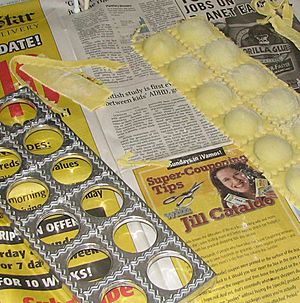Alkaline pasta facts for kids

Alkaline pasta being rolled out on an Italian pasta machine
|
|
| Main ingredients | Durum wheat, flour, alkali |
|---|---|
Alkaline pasta is a unique kind of pasta or noodle. It has a higher amount of something called alkali than regular pasta. You might know famous alkaline noodles like Japanese Ramen and Chinese Lamian.
Adding alkali changes the noodles in cool ways. They become more slippery and elastic. They also get a nice yellow color. This yellow color comes from natural parts of flour called flavones. These parts turn yellow when they mix with alkali. You can use different flours to make them, like regular white flour or semolina flour.
Contents
What Makes Noodles Alkaline?
Noodles become alkaline by adding special ingredients. The most common ingredient is sodium carbonate. This is a type of salt.
In some parts of China, people traditionally use alkaline water from wells. This water naturally contains the right minerals. More often, a mix of sodium carbonate and potassium carbonate is added to the dough. This mix is called jian in Chinese and kansui in Japanese. Sometimes, kansui can also be a liquid or powder with other similar salts.
Traditional Chinese Noodles
Some Chinese noodles, like the chewy "hand-pulled" Lamian from Gansu Province, use a special alkali. This alkali is called peng hui. Traditionally, peng hui came from the ash of a plant. It contains potassium carbonate. This makes the noodle dough softer and more tender. It also helps the noodles stretch without breaking.
Today, there are artificial versions of peng hui. These are made from a mix of salt and other sodium compounds. "Lanzhou pulled noodles" are very famous. Even if they are not from Lanzhou, the name means they are delicious.
Making Alkaline Noodles at Home
You can even make alkaline noodles at home! A food scientist named Harold McGee found a simple way. You can bake regular baking soda in the oven. Bake it at 300°F (150°C) for about an hour.
When you bake baking soda, it changes. It releases water and carbon dioxide gas. What's left is sodium carbonate, which is alkaline. You only need a tiny bit of this baked baking soda. For example, just one teaspoon for 1-1/2 cups of semolina flour.
First, dissolve the baked baking soda in a little water. Then, slowly add this water to the flour. After kneading the dough, let it rest for an hour. Then, you can roll it out very thin. You can use a pasta machine to make your favorite noodle shapes.
See also
 In Spanish: Kansui para niños
In Spanish: Kansui para niños



